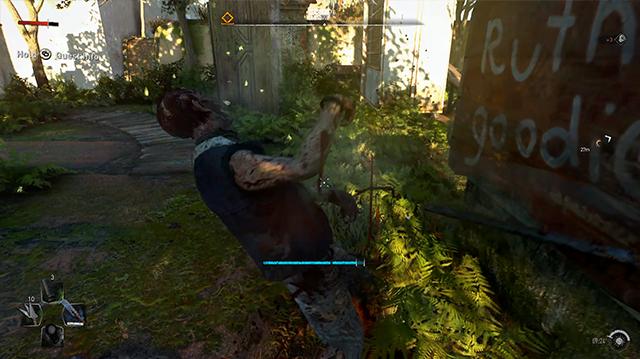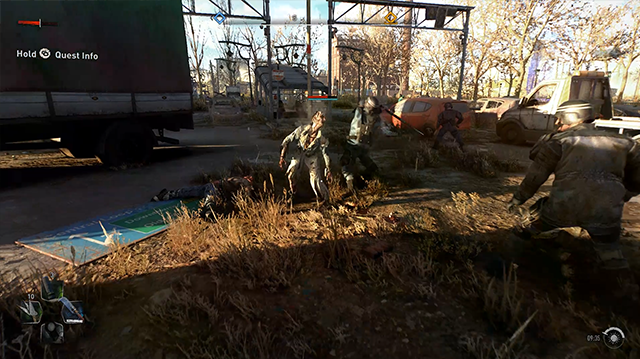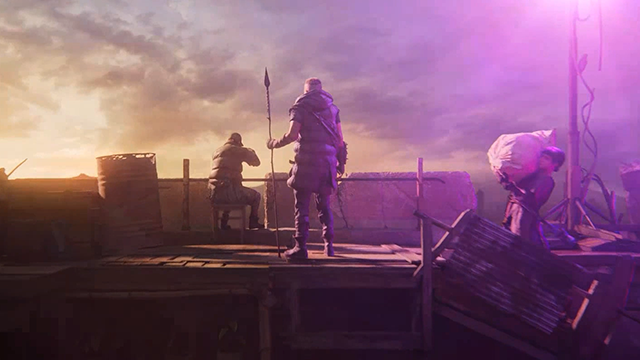Dying Light 2: Stay Human shows every indication of massively improving on the already very solid original. Its tighter controls, greater verticality, and satisfying action weren’t lost on us in our hands-on preview. But it was improvements to the narrative and the fleshed-out characters that really stood out. It is fortuitous, then, that we had the chance to sit down with Piotr Szymanek, Narrative Director for Dying Light 2, and discuss what’s in store.
Dying Light 2, Szymanek tells me, takes place 20 years after the original. Humanity is living in a new Dark Ages. Civilization, as we know it, has collapsed, and people are trying to build a new civilization from scratch.

“There is no London, there is no Rome, there is no Paris anymore. Everything that is still on the planet is very, very small Survivor camps. And Pilgrims are responsible for the contact between those survivors.”
You play as Aiden Caldwell, one of these Pilgrims. These are the people that make the dangerous trek from settlement to settlement, connecting the disparate communities found in Dying Light 2. These are hardened people, often ex-criminals, who don’t fit in with other Survivors. Szymanek describes them as “pretty brave, and pretty desperate”. Aiden is searching for his sister, and comes to the city of Villador to find answers.
“At the beginning of the pandemic, people found many infected inside (Villador), so they built walls surrounding the city from the outer world. But what was from the beginning the curse of the city, because the infection was found there, eventually saved the city and its inhabitants.”
Being ground zero gave those in Villador a chance to study the virus before the world collapsed. They developed the biomarker, which suppresses the effects of the zombie-like infection, allowing them some level of control over the disease. Everyone in the city is infected, but only some have turned into the monsters crawling the streets.
“The people,” Szymanek says, “are still just infected, but fighting the infection every day. That’s why ‘Still Human’ is our subtitle for the game. Because it’s always the struggle to stay human.”
The Living, the Dead, and the Living-Dead

This idea of people trying to simply live their lives in this new Dark Age is deep in the DNA of Dying Light 2.
“Humankind has always struggled with very big and sometimes hard moments. But what we as a species have in common is that we can live in every extreme condition.”
Szymanek looked to real examples from human history for inspiration. The fall of Rome, the collapse of ancient Greece, eras where the most sophisticated civilizations collapsed. Actual periods of societal decay provided a blueprint for what may happen.
“What happened back then, was not like, you know, the whole civilization just wiped out and medieval times were built on nothing. They used what the Roman Empire established, but they used it in a different way. That’s exactly what people in Villador were doing. They’re rebuilding the civilization on the scratches of the last one.”
According to Szymanek, everyday items like refrigerators and televisions that no longer function still have uses. It’s why weapons are makeshift, and crafting is haphazard.
One early mission has you helping a would-be craftsman make a simple electric fence to control livestock. The results aren’t quite what he had in mind, but what he makes can be repurposed into a helpful weapon mod. The world-building informs the game systems in a very deliberate way.
Deep Characters in a Dark World

“When we were creating characters, we’re always asking ourselves, ‘What was this guy or this woman doing before the pandemic, before it all went to hell?’”
The original Dying Light was well regarded, but NPC’s had a tendency to blend together. Making fleshed-out people, with their own lives and motivations, was a focus for this sequel.
Szymanek gives me an example of a boy you can encounter, looking for his lost dog. The boy is a serious canine enthusiast, and, as kids tend to, wears his enthusiasm on his sleeve.
“The reference to him was, for example, Tim from Jurassic Park, who was like crazy into dinos. So, we have this boy who is crazy about dogs. And he’s constantly talking to the player about some interesting stuff about dogs all the time. So, yeah, every time in with each character, we are asking ourselves, ‘Who he was, what he wants, what’s his journey? What will be his character’s arc?’”
Choices Matter in Dying Light 2

Advancing the narrative and world-building also means reinforcing the importance of choices. There are different factions with competing interests, and it’s up to you as Aiden to decide who to support and when. These decisions alter the path of the story and are reflected in the city. According to Szymanek, there are three types of choices players make.
“First, the most important choices in the game will influence the finale, the end game itself. It will influence with whom will you end the story, how the city will look like when they end the story.”
These are largely the choices in the core narrative. Think about the big decisions you make in something like Mass Effect. Different playthroughs will have branching stories and different endings depending on what you choose.
“The second one is obviously inside the quests. So for example, if the NPC will be your ally or not, or you will get rewarded for what you’ve done or not.”
I saw that first hand in my preview. Dialogue choices can make you friends and enemies. People living in the world may come to you for help, or threaten your life over limited supplies.
The third type is the City Alignment system. There are key buildings and zones to capture. Once you do capture them, you must decide which city faction gets control. In the first region, for example, you can choose between the paramilitary Peacekeepers or the more cooperative and community-focused Bazaarians.
“Peacekeepers are using completely different kinds of survival than Bazaarians do, and there will be more patrols in the city. So there will be fewer infected. But when you will give the same structure to Bazaarians, you will find more zip lines, you will find more equipment to do the parkour.”

Dying Light 2: Stay Human is a game of great promise. Leaning into its world-building and well-developed characters may be just what the series needs to take a step forward and join the iconoclasts of the post-apocalypse genre.
The way choices affect the story is intriguing. Whether developer Techland can deliver on these promising elements remains to be seen, but we will find out when Dying Lights 2: Stay Human releases for Xbox, PlayStation, Nintendo Switch Cloud Games, and PC on February 4, 2022.







Published: Nov 17, 2021 03:09 am